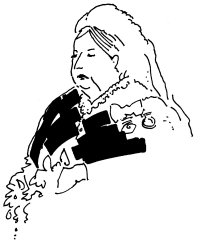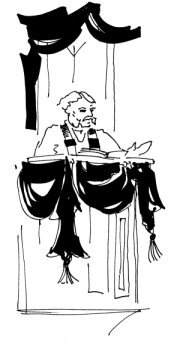
|
St Peter's Magazine, February 1901
"The Queen is dead. Long live the King!"
 This
month we present a further selection of extracts from the St Peter's
magazine of one hundred years ago. January 1901 was a momentous month for
St Peter's church, as it was for the whole country, being the month in
which Queen Victoria died (22 January 1901). The descriptions of the
services to commemorate her life and death formed the main material of the
February magazine.
This
month we present a further selection of extracts from the St Peter's
magazine of one hundred years ago. January 1901 was a momentous month for
St Peter's church, as it was for the whole country, being the month in
which Queen Victoria died (22 January 1901). The descriptions of the
services to commemorate her life and death formed the main material of the
February magazine.
The Church fabric
St Peter's church has not changed dramatically since 1901. However the South door was not in use, although not yet plastered up, the nave and aisles were in poor repair - a constant source of worry to the 'Working Party' (see below), and the south clerestory was blocked up. There was a large Victorian pulpit but no dais in the nave, a late twentieth century creation. Although there was no St James's Room, because St James' parish was still independent, there was a church hall, an Infant school, and Boys' and Girls' Junior schools; all in the Broad Marsh. The churchyard was a little bigger, although the widening of St Peter's Gate in the late 19th century had reduced it on the north side, and where the St Peter's Centre now stands was the street called St Peter's Church Side linking through to Low Pavement. At the west end, steps led down from the church door through an arched gateway into St Peter's Square.
Memorial services
 The
church was completely draped in black for the services on 27 January to
commemorate Queen Victoria. Apart from the pulpit, whose drapes were paid
for by Mr Sibley, the draperies and the cost of putting them up were
funded through the Parish Magazine Account by the Hon. Secretary, Mr. E.C.
Smith. The services were described as "solemn" with "hymns and music
for the day of a deeply impressive character". The services closed with
the congregation standing in silence while the "Dead March in Saul"
was played.
The
church was completely draped in black for the services on 27 January to
commemorate Queen Victoria. Apart from the pulpit, whose drapes were paid
for by Mr Sibley, the draperies and the cost of putting them up were
funded through the Parish Magazine Account by the Hon. Secretary, Mr. E.C.
Smith. The services were described as "solemn" with "hymns and music
for the day of a deeply impressive character". The services closed with
the congregation standing in silence while the "Dead March in Saul"
was played.
The Rector "devoted the greater part of his sermons to a tribute to the late Queen" taking as his text Jeremiah 9 (21). The Magazine claimed he described "the nation [as] sobbing" with "every heart... sad", there being "great mourning in the land from the highest to the lowest". His view of Queen Victoria, "alone in grandeur, yet in touch with her people, a pattern to all, guided by divine Grace [whose] wisdom had marked all her intercourses with her people", was conventional for its day.
On Saturday 2nd February there was a special memorial service for Queen Victoria at 1.00pm. Before this service "deeply muffled peals were rung by the ringers of St Peter's". So large a congregation came, according to the Magazine, that despite extra seating, "a large standing concourse filled the aisles, and many persons were unable to gain admission". The Special Order of Service (shorter version) was described as "fully choral". The Rector's text on this occasion was Job 14 (14). Again the service closed with the "Dead March in Saul". On Sunday 3 February the bells were rung half muffled and "before Evening service a special quarter peal of Grandsire Triples was rung".
David Stainsby, Master of the Ringers, explains that when church bells are rung (as opposed to chimed) the bells are in a mouth-upward position and swung through a full circle, each bell sounding once as the clapper strikes the bell. This is the handstroke blow. The backstroke blow follows as the bells reverse in direction moving through a full circle back to their first position, again striking once. To half muffle the bells, a leather muffle is fitted to one side of the ball of the clapper to deaden the sound of the backstroke blow. For fully (deep) muffled ringing, muffles are fitted to both sides of the clapper ball. Generally, half muffled is preferred, the quieter backstroke giving a mournful effect.
Lent
With such a grim opening, it was perhaps appropriate that February was the month of preparation for Lent. The Motto for the month, "These hear us not" (Luke 8,13) was used by the Rector, George Edgcome, for some "earnest and solemn teaching". He urged his parishioners to "question [themselves] about the kind of reception which the good seed, the Word of God, has received at our hands" and, quoting examples from some relevant parables, exhorted them to "seek evidence of the abiding Spirit working within us."
Parish work
In St Peter's Parish evidence of the "abiding Spirit working within us" was manifested, perhaps, in the extensive social work undertaken by some of its members. The regular outreach groups seemed to have had quite sizeable numbers attending: The Girls Evening Home had 30 attendees for tea at its Christmas party; the Girls Friendly Society party had 40 attendees; the Band of Hope temperance meeting had 86 children in attendance at its Christmas treat of "buns, biscuits, coffee, nuts, toffee and oranges", the oranges were donated by Mrs Denman. Even at a regular evening meeting, e.g. 30 January 1901, there were 58 children.
The activities of these groups give an insight into their purposes. Girls Evening Home focused its regular Monday evening meetings on "sewing and recreation", although a number of girls were said to be wanting to take part in "drilling" (physical exercise), as they claimed to feel "a benefit to their health from exercise" after their days at work. The Infant Sunday School prizes in January 1901 were mainly articles of clothing given or made by the teachers. Prayer books were only distributed to those going on to the Boys' and Girls' Schools. The Band of Hope and the Girls Friendly Society had "instructive addresses" as some of their regular meetings.
Finance
Where the money came from for these activities is not clear. The Offertories for February were dedicated once again to the Sick Poor (six collections, average size 13s.8d, a fall of 26% on December 1900); church expenses (four collections averaging £1.0s.2d, a fall of 29% on December 1900); and a hospital, on Hospital Sunday (27 February) when two collections raised £11.5s.0d. The Working Party - seemingly the fund raising committee of the Parish - chose to focus its work on the church fabric to "free the church of its debt on the Restoration Fund". It planned to hold a three-day sale at the end of 1901, probably in one of the City halls. [N.B. this subsequently took place on 10-12 October and raised £175 against the debt of £200.]
So February, and the approach to Lent in 1901, engendered more solemnity even than usual.
Links
Return to the History contents page
http://www.stpetersnottingham.org/1901/02.html
© St Peter's Church, Nottingham
Last revised 3rd February 2001